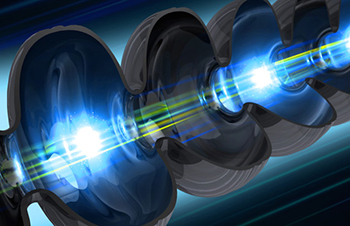Construction Begins on Revolutionary X-Ray Laser
 MENLO PARK, Calif. — Construction began on April 4 to upgrade a revolutionary X-ray laser, known as Linac Coherent Light Source (LCLS), at the Department of Energy’s (DOE) SLAC National Accelerator Laboratory in Menlo Park.
MENLO PARK, Calif. — Construction began on April 4 to upgrade a revolutionary X-ray laser, known as Linac Coherent Light Source (LCLS), at the Department of Energy’s (DOE) SLAC National Accelerator Laboratory in Menlo Park.
The project, known as LCLS-II, will add a second X-ray laser beam to LCLS that is 10,000 times brighter, on average, than the first and fires 8,000 times faster (up to a million pulses per second.) The project will increase the power and capacity of the LCLS for experiments to provide more in-depth view of how nature works on the atomic level and on ultrafast timescales, according to a statement.
SLAC is a multi-program laboratory that explores photon science, astrophysics, particle physics and accelerator research, and is operated by Stanford University for the Department of Energy’s Office of Science. To make this major upgrade a reality, SLAC teamed up with four other national labs — Argonne, Berkeley Lab, Fermilab and Jefferson Lab — and Cornell University, each of which will make key contributions to project planning as well as to component design, acquisition and construction.
“LCLS-II will take X-ray science to the next level, opening the door to a whole new range of studies of the ultrafast and ultrasmall,” said LCLS Director Mike Dunne in a statement. “This will tremendously advance our ability to develop transformative technologies of the future, including novel electronics, life-saving drugs and innovative energy solutions.”
When it debuted six years ago, LCLS was the first light source of its kind, with an X-ray microscope that uses the brightest and fasted X-ray pulses ever made to provide unknown details of the atomic world. Scientists use it each year to study fundamental process in nature. For instance, it helps capture molecular video to reveal how chemical bonds form and break; ultrafast snapshots that show electric charges as they rearrange in materials and change properties; and 3-D images of disease-related proteins that show atomic-level details that could help with medical research.
The new X-ray laser will work together with the existing one — each of which will occupy one-third of SLAC’s 2-mile long linear accelerator tunnel. They will work together to allow researchers to make observations over a wider energy range, capturing even more detailed snapshots of rapid processes.
“The upgrade will benefit X-ray experiments in many different ways, and I’m very excited to use the new capabilities for my own research,” said Brown University Professor Peter Weber, who co-led an LCLS study that used X-ray scattering to track ultrafast structural changes as ring-shaped gas molecules burst open in a chemical reaction vital to many processes in nature, in a statement. “With LCLS-II, we’ll be able to bring the motions of atoms much more into focus, which will help us better understand the dynamics of crucial chemical reactions.”
The $1 billion project is being funded by the Office of Science and is scheduled to begin operations in the early 2020s. Until then, LCLS will continue to serve the X-ray science community, except for a six-month time period in 2017 and a 12-month time period from 2018 to 2019 due to construction.
